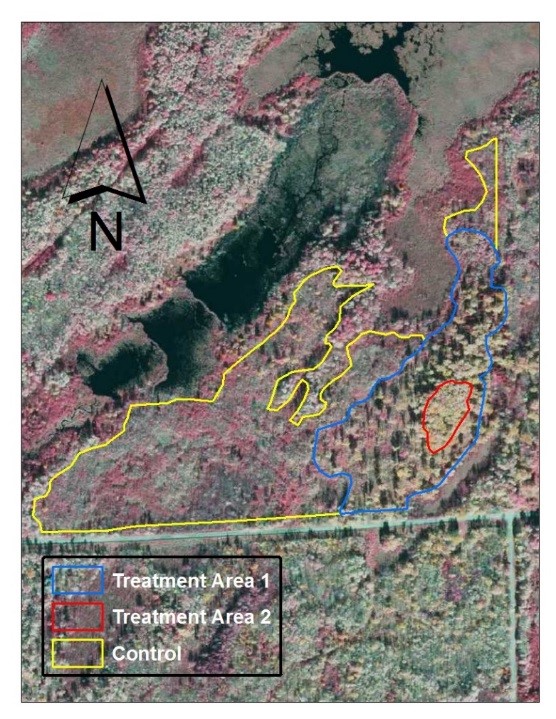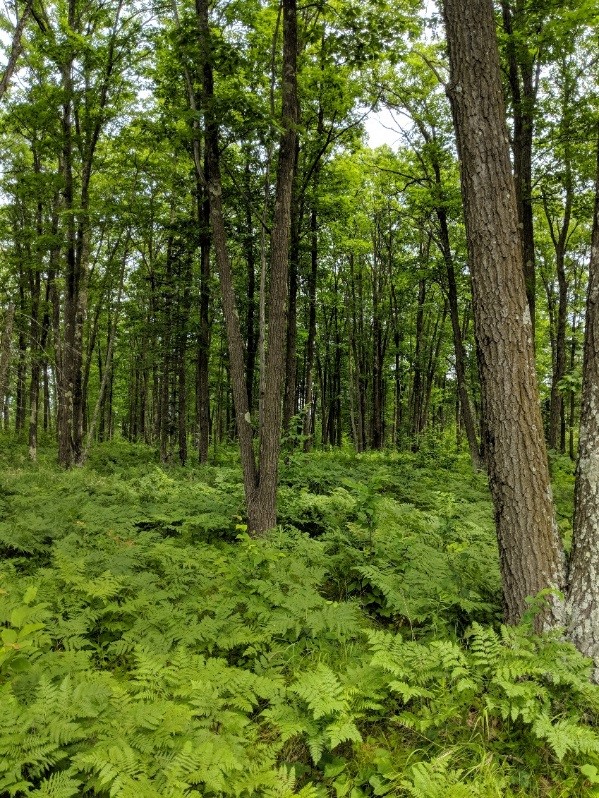Overview
This case study describes three treatments in an MHn35 stand in the Nemadji State Forest. The silvicultural objective was to use the shelterwood method at two residual basal area levels, combined with soil scarification using a floating disc trencher, to naturally regenerate birch and oak. For additional comparison, one treatment also included a clearcut plot that received no scarification treatment. The scarification treatment with the 35 ft2/acre residual BA resulted in adequate stocking of paper birch and a fair amount of northern red oak regeneration. The scarification treatment with 75 ft2/acre residual BA resulted primarily in sugar maple regeneration. The unscarified clearcut plot regenerated primarily to aspen. The authors conclude that a good seed crop in adjacent stands, soil scarification, and the right amount of shelter were important factors in producing the desired regeneration.
Silviculture Objective(s)
The objective of this case study was to evaluate methods for naturally regenerating paper birch using the reserve shelterwood method, with various levels of overwood retention. This treatment was coupled with seed bed preparation using perpendicular passes of a disk trencher with disks in the "open" or "float" position to maximize surface area disturbed.

Figure 1. Treatment area map.
Pre-treatment stand description and condition
Pre-treatment species composition:
This stand was healthy, forty years old, and dominated by aspen with birch, maple, balsam fir, black ash, and northern red oak. Pre-harvest appraised volume by species is found in Table 1.
Pre-treatment growth and stocking:
Not available.
Pre-treatment forest health issues:
None were noted.
Silviculture Prescription
The prescription for this stand included three levels of retention following timber harvest combined with seed bed preparation using perpendicular passes with a disk trencher in the "open" or "float" position to maximize surface area disturbed. Following MNDNR regeneration standards, we had a target of 1,200 trees per acre of birch regeneration on 90% of plots 4 years after seed bed preparation.
This stand was whole tree harvested and biomassed (tops and slash chipped and moved off site for energy production) in July and August 2007 with conventional equipment. The control/untreated portion of the stand was clear-cut with a reserve. All ash, oak, balsam fir, and spruce were reserved. No birch seed trees were reserved during harvest. There are 2 different treatment areas; 10 acres with a residual BA of 36 sq. ft. of oak, and 1 acre with a residual BA of 75 sq. ft. Both treatment areas were double disc trenched (second pass perpendicular to the first) to expose mineral soil. The disc was lightly floated over the site.

Figure 2. Treatment area 1 (trenched, 36 BA over-wood) showing free-to-grow dense paper birch.

Figure 3. Treatment area 2 (trenched, 75 BA over-wood) showing oak overstory and fern dominated understory
What actually happened during the treatment
The site was harvested in July and August of 2007 yielding 17 cords per acre on average across all treatments (Table 1). All treatments were executed as described in "Silviculture prescription".
Table 1. Harvest volumes from site appraisal by species.
| Species | Cords | Cords per acre |
| Trembling aspen | 576 | 13 |
| Paper birch | 83 | 2 |
| Big tooth aspen | 64 | 1 |
| Sugar maple | 25 | 1 |
| Total | 748 | 17 |

Figure 4. Disk trencher in action
Post-treatment assessment
The goal to regenerate paper birch was a success in treatment area 1 where paper birch regenerated at 3,556 stems per acre and 100% stocking (Table 2). Northern red oak also regenerated well at 822 stems per acre and 100% stocking. Maple regenerated at 867 stems per acre in treatment 1.
Treatment area 2 seemingly had too much residual crown cover and competition by sedges and ferns for birch to propagate and favored regeneration of shade tolerant sugar maple at 500 stems per acre, northern red oak at 150 stems per acre, and paper birch at 50 stems per acre.
Treatment area 3 (control) was dominated by trembling aspen at 4357 stems per acre but also had regeneration of birch, oak, maple, and ash.
All objectives of the site prep were met. Mineral soil was exposed enough for birch to germinate. The overwood provided enough light for germination and growth of shade intolerant birch and oak but allowed enough precipitation in and buffered drying of the seedbed. Aspen was set back enough for paper birch to establish, but still remains a component in the stand. Very little root damage or dieback was observed on residual timber due to an optimal shallow trenching job. Even though no birch seed trees were left, birch seed rain from adjacent stands was adequate.
Table 2. Regeneration results by treatment and species. Values are stems per acre.
| Treatment | Paper birch | Northern red oak | Red maple | Sugar maple | Trembling aspen | Black ash | Total |
| 1) Shelterwood, residual basal area 36 ft2/ac, double disc-trench | 3556 | 822 | 411 | 456 | 467 | 0 | 5712 |
| 2) Shelterwood, residual basal area 75 ft2/ac, double disc-trench | 50 | 150 | 0 | 500 | 0 | 0 | 700 |
| 3) Clearcut, no disc-trench (control) | 214 | 429 | 929 | 143 | 4357 | 0 | 7001 |
Plans for future treatments
No plans currently, but mechanical stand improvement using brush saws to increase spacing and control composition is commonly used in this area in younger developing stands.
Costs and economic considerations
Site preparation: double float disc-trench cost $90 per acre
Other notes
This case study was edited and submitted by MN DNR Silviculture Program Staff Doug Hecker and Mike Reinikainen on 01/25/2019.
Climate Adaptation Considerations
The Nemadji State Forest is on the southern end of paper birch’s range. Under predicted conditions, this range will shift to the north. However, maintaining the paper birch cover type on the landscape is still a goal of the department. Other species favored by Treatments 1 and 3, such as northern red oak and red maple, are predicted to increase in abundance in the area around the Nemadji State Forest under most climate modeling scenarios.
Summary / lessons learned / additional thoughts
The overall objective to regenerate paper birch was met. According to the regeneration data collected, creating a scarified seedbed was effective for regenerating birch and also favored oak where residuals basal area was 36 ft2/acre. Even though no birch seed trees were left, birch seed rain from adjacent stands was adequate because paper birch seed is light in weight and wind dispersed. It cannot be concluded which residual basal area produces optimum regeneration as treatment 3 (control) did not have trenching. If a portion of the clear-cut area had been trenched, we would have more definitive results. However, according to research (Perala and Alm, 1989), some level of shade can help regenerate birch because it prevents the mineral soil from drying out quickly, as in the 36 ft2/acre treatment. This treatment was also very effective for regenerating northern red oak. It appeared that the shelterwood with an average residual basal area of 75 ft2/acre was not effective at establishing shade mid-tolerant to intolerant species, but heavy sedge and fern competition may have contributed to this.
